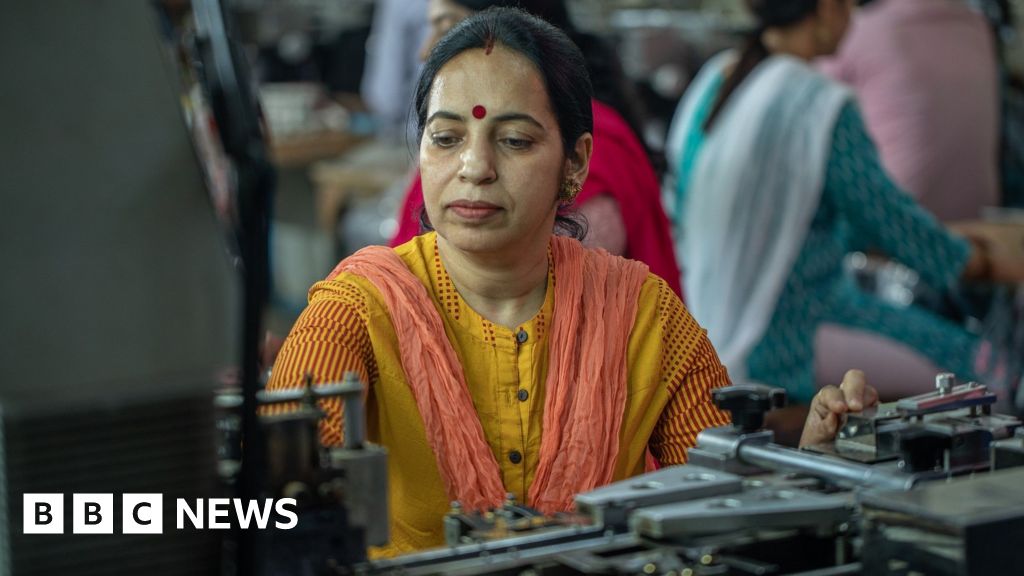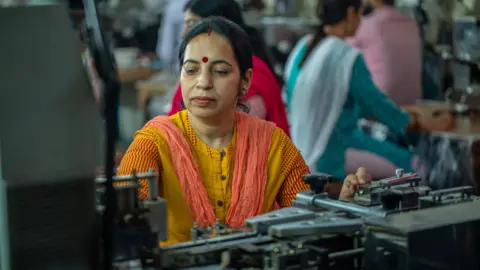
 Getty Images
Getty ImagesA new study highlights how promoting female entrepreneurship can greatly enhance women’s workforce participation. By creating more opportunities for other women, female-led businesses can drive significant economic growth, it says.
Imagine a world where women, though half the population, own less than a fifth of businesses.
This is the reality the World Bank uncovered in a survey spanning 138 countries from 2006 to 2018.
Even more intriguing is how female-owned businesses empower other women.
In male-owned firms, only 23% of workers were women, but female-owned businesses employ far more women. And while just 6.5% of male-owned businesses have a woman as the top manager, over half of female-owned firms are led by women.
In India, the situation is even more challenging. Female labour participation and entrepreneurship are low, with the total number of women in the workforce barely changing over the past 30 years.
But the picture looks slightly better when it comes to entrepreneurship.
Women make up about 14% of entrepreneurs and own a significant share of micro, small, and medium enterprises (MSMEs). They contribute notably to industrial output and employ a substantial portion of the workforce, according to the 2023 State of India’s Livelihoods Report.
Most MSMEs in India are microenterprises, with many women-owned businesses being single-person ventures, according to Niti Aayog, a government think-tank. While some women-owned enterprises employ staff in big numbers, a large majority operate with very few workers.
 Getty Images
Getty ImagesSo Indian women are not really under-represented in entrepreneurship, but they operate much smaller firms than men – especially in the informal sector.
Not surprisingly, women’s contribution to India’s GDP is just 17%, less than half the global average. And India ranks 57th out of 65 countries for women’s entrepreneurship, according to the Global Entrepreneurship Monitor Report 2021.
A new paper by Gaurav Chiplunkar (University of Virginia) and Pinelopi Goldberg (Yale University) argues that promoting female entrepreneurship could significantly boost women’s workforce participation, as female-led businesses often create more opportunities for other women.
The authors developed a framework to measure the barriers women in India face when entering the labour force and becoming entrepreneurs.
They found substantial obstacles to women’s employment and higher costs for female entrepreneurs when expanding their businesses by hiring workers. Their simulations showed that removing barriers would boost female-owned businesses, increase women’s workforce participation, and drive economic gains through higher wages, profits, and more efficient female-owned firms replacing less productive male-owned ones.
 Getty Images
Getty ImagesSo, policies that support female entrepreneurship are crucial, the authors argue. Policies that boost entrepreneurship and increase labour demand – allowing more women to become entrepreneurs – can be more effective – and quicker – than changing long-standing social norms, says Mr Chiplunkar.
“History tells us that norms are sticky,” says Ashwini Deshpande of Ashoka University.
Women still shoulder most household chores – cooking, cleaning, laundry, childcare, and elder care. There are more barriers, including limited access to safe, efficient transportation and childcare, restricting their ability to work within commuting distance. Even women’s limited ability to travel independently is a key factor restricting their participation in the labour market, as shown in a recent study led by Rolly Kapoor of University of California.
Despite a recent uptick in India’s women’s labour force participation, the picture is not as promising as it seems, as Ms Deshpande notes in a paper.
The increase, she found, reflected an increase in self-employed women, a combination of paid work and disguised unemployment, a situation where more people are employed than actually needed for a task, resulting in low productivity.
 Getty Images
Getty Images“There is an urgent need to increase women’s participation in regular salaried paid work with job contracts and social security benefits. This would be the most important step, albeit not the only one, towards women’s economic empowerment,” says Ms Deshpande.
It’s not going to be easy. For one, many women face obstacles – from families and communities – to working at all, regardless of whether they want to be entrepreneurs. And if more women join the workforce but there aren’t enough jobs – because barriers to starting businesses remain – wages could actually drop.
Research shows that women in India work when opportunities arise, indicating that the declining labour force participation rate is a result of insufficient jobs and reduced demand for women’s labour. A recent Barclays Research report says India can reach 8% GDP growth by ensuring women make up over half of the new workforce by 2030.
Boosting female entrepreneurship could be a way out.

